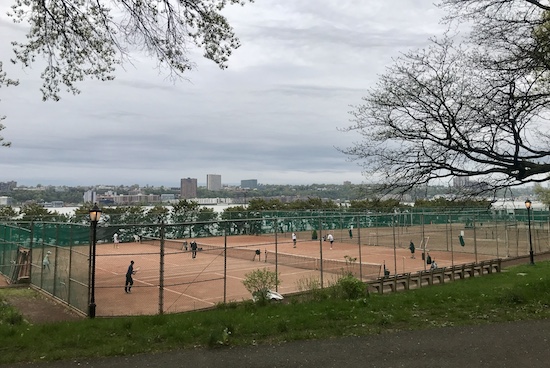
The 96th Street courts on a recent Sunday.
By Alex Israel
A popular set of public tennis courts in Riverside Park has increasingly been monopolized by an enterprise operating expensive tennis lessons and clinics, leaving local tennis players unable to get court time, according to multiple players who spoke to the West Side Rag.
The 96th Street Clay Tennis Courts, also known as the Oscar Hijuelos Clay Courts, are the only public, outdoor red-clay courts in Manhattan. The ten-court facility is currently operated by the Riverside Clay Tennis Association (RCTA), a private non-profit contracted and wholly owned by the Riverside Park Conservancy (RPC), also a private non-profit. RPC partners with the City of New York—specifically the NYC Department of Parks and Recreation (NYC Parks)—to oversee operations throughout Riverside Park, and is free to contract additional organizations and vendors as it sees fit.
According to RPC’s website, the RCTA was initially formed in the 1990s to facilitate the transformation of the courts in “deplorable condition” to the “magnificent public red-clay facility that exists today” through petitioning and lobbying of local politicians. Since then, a team of RCTA volunteers and staff have worked to maintain the courts, which require more attention than others with asphalt or concrete surfaces.
While no one has protested the quality of the upkeep, some local tennis players say that the courts have become oversaturated with paid programming over the last few years, and worry that a similar dynamic will play out at Riverside Park’s hard courts at 119th street, which they have turned to as an alternative.
The RCTA’s website lists more than 85 separate sessions of individual and group programming at the 96th Street courts between April through August, falling on every day of the week and ranging from 11 a.m. to 7 p.m. That doesn’t include the kids’ camp that runs from June through August from 11 a.m. to 3:30 p.m. or any private lessons that are scheduled outside of the pre-set sessions.
Lester Schulman, an Upper West Side resident for fifty years, used to use the 96th street courts often, as he found them to serve as “excellent resources for an aging demographic” due to the clay’s forgiving nature and ease on the body. But by his account, programs implemented over the last four years “took up all the courts during the daytime hours,” making it nearly impossible for him to get time there.
According to Lou Seitchik, a local tennis player and donor to Riverside Park, 96th Street became so crowded that he stopped attempting to walk on. “It’s hard to get on, it’s so full of lessons and teachers … even during the day and during the week,” he said. “In our point of view, the courts are supposed to be for the permit holder, not for what appear to be profit-making operations.”
Jeff Cohen, a self-proclaimed “tennis addict” whose career as a theater director and playwright allows him to play tennis during the daytime, believes the RCTA “has instituted a ‘profit scheme’ at the 96th Street courts.” In his experience, “at any one time, as many as 60% of the courts are used by the RCTA for-pay programs.”
A month into the season, the RCTA was still working to resurface three of the ten public courts at 96th Street. One Sunday last month at 3 p.m., it appeared that two of the seven open courts were being used for paid lessons—leaving five available for public use. These five open courts remained busy with players for the next few hours.
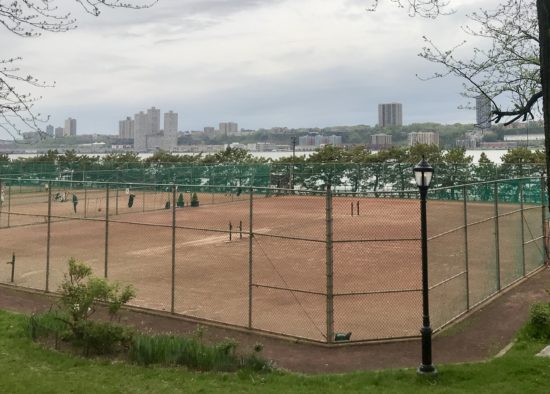
Some courts were being resurfaced last month.
The RCTA and NYC Parks, however, refute the complaints, saying that there are often a majority of courts available for public use. “We always try to have seven courts available for walk-on play,” said Mark McIntyre, the Executive Director of the RCTA, in a phone interview with West Side Rag. He says this sometimes means his team will block out reservations for one or two courts at a time to ensure they are available for walk-on players to use. But according to McIntyre, “there are some periods of time where it’s just so dead, it doesn’t really matter.”
In response to concerns about the RCTA’s busy programming schedule, McIntyre estimated that lessons take up 15% of all the court availability. “The camp doesn’t take away anything from the public … We don’t use very much of the total availability of public court time for programming, and when we do it is primarily during non-peak times—and there’s usually empty courts during that time.” McIntyre believes that even if the RCTA didn’t host camp on the courts, they’d be “deserted.” “Nobody plays in June, July, and August,” he said.
A statement from NYC Parks via email with West Side Rag provides the same estimate. “NYC Parks recently conducted an audit of the 96th St. tennis courts, only 20 of the 140 operational hours are used by programming. We are confident that Riverside Park Conservancy’s operation of the 96th Street Courts is not displacing public access.” Their observation on Thursday, May 10 at 5 p.m., showed that “the courts were empty except for children, and there were no walk-up sign ups/requests to play otherwise.”
However, in an email blast from May 1, McIntyre seemed to address some crowding during the month of May. The email outlines the process for resurfacing the remaining three courts and asks that visitors avoid playing in the afternoon due to a “court squeeze” driven by for-pay programming. “This week, we start our Junior Ace programs in the 4 and 5 o’clock hour, so during those times there will be a court squeeze until we get all of the courts finished. Again, please bear with us and, if possible, avoid those late afternoon hours Monday through Friday,” writes McIntyre.
McIntyre says that his team closely monitors the usage of the courts, and suggested that he has records to back up his and NYC Parks’ assertions of the breakdown between public use and for-pay programming. However, at the time of publishing, he has not shared that raw data with West Side Rag.
According to the NYC Parks Concessions Directory, many other courts, including in Central Park and in Riverside Park at 119th Street, have a vendor who is licensed as the single concession for that location. In a past iteration of the Tennis Pro contract available via public record, it stated that these vendors were licensed to only operate on one court at a given time. This had prevented an abundance of paid programming from becoming an issue at 96th Street—until the single vendor operation was “abolished” when the RCTA officially took over management of the programming in 2006, according to Cohen.
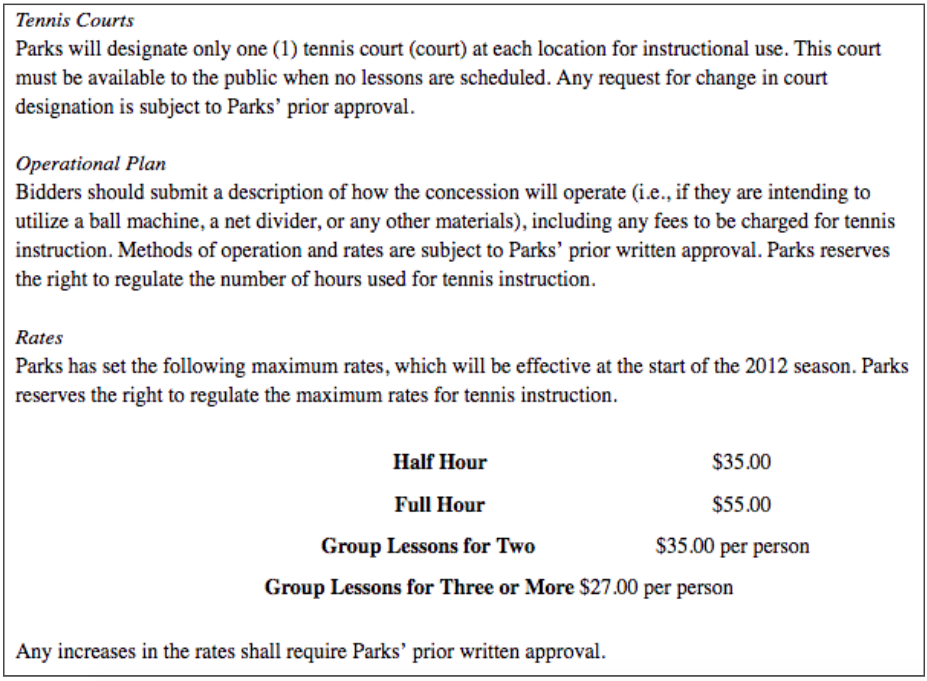
A portion of the NYC Parks Tennis Pro Vendor contract from 2012 states the City rules for instructional play, including rate limitations. According to the RCTA website, all private lessons with any of the RCTA pros are currently priced at $70 per hour. RCTA group lessons can get up to $75 per session depending on age and skill level.
But public concerns go beyond the lack of court availability. Several people interviewed for this article said they take issue with the lack of transparency provided by the RCTA and the RPC in their operations of these public facilities.
“I understand they need a certain amount of money for upkeep, which they do a good job of,” Schulman said. “But how much is assigned to just maintenance and how much is assigned to the people who run it?” he asked.
Cohen says he has made repeated attempts to open up a dialogue with RCTA, RPC, NYC Parks, and other City offices about his concerns with the courts, but says that those entities have been “unresponsive,” if not outright “unfriendly.” “Complaints were either ignored or no action was taken,” said Cohen.
Local players are also concerned with what appears to them as a lack of governance on behalf of the NYC Parks—or as Schulman put it, the transfer of “public land into private hands.”
Whether or not a majority of the courts are booked for structured programming, “the problem is one of priorities,” he said. “[RCTA] programs are the priority and everyone else has to adjust and take a back seat.”
“It seems like the Conservancy can do whatever it wants,” said Seitchik. “Are the courts being used for the purpose that the Parks Department says they’re supposed to be used for?” he asked.
Within the most recent iteration of the contract between NYC Parks and RPC, obtained by a Freedom of Information Act (FOIA) request from one of the concerned players, there is no clause that explicitly calls for them to host classes and lessons—but there is also no clause that bars them from doing this.
According to the document, which was set to expire in March 2018, RPC was contracted to use “the revenue generated from the Courts’ fees towards the maintenance, upkeep, and operation of the Courts.” The only court fee explicitly listed in the contract was for the standard amount of a single-play permit on the spot ($15 a person) if a guest does not already possess either a full-season permit or a pre-printed single-play permit. Full-season tennis permits in New York cost $100 and allow people to play at dozens of courts throughout the city.
Requests to see an active contract were denied by NYC Parks and McIntyre. A NYC Parks representative shared that they are “currently negotiating a new agreement with RPC, so we can’t yet comment on what RPC’s contractual obligations will look like in a new agreement.” RPC did not respond to a request for comment.
McIntyre said that the for-pay programming is the RCTA’s biggest moneymaker. On the RCTA’s ‘About’ page, they claim to raise over $650,000 in annual revenue. McIntyre estimated the revenue breaks down as follows:
NYC Park Fees: 20-25% (approximately $130,000 – $162,500). This includes the cost of aforementioned full-season permits and single-play permits.
Non-profit Fundraising: 20–25% (approximately $130,000 – $162,500). This is made up of donations and membership dues directly to RCTA.
RCTA Programming: 50-60% (approximately $325,000 – $390,000). This encompasses the line-up of paid events, including summer camps as well as private and group lessons for children and adults.
He also offered an overview of how the revenue gets redistributed, breaking the RCTA’s budget out into three categories and loosely estimating costs associated with each. According to McIntyre, “labor is the biggest expense,” with employee salaries making up an estimated 60% of the budget.
Maintenance & Operations: This category includes the cost of salaries for one full-time employee exclusively for maintenance, and two full-time employees who split their time between maintenance and operations. It also includes the annual cost of materials, which McIntyre estimated at between $70,00 and $100,000. (It’s difficult to say whether this estimate is high or low for the industry. A quick look at one local vendor’s wholesale prices allowed West Side Rag to estimate a cost of around $45,000 in surfacing materials for ten clay courts throughout a single season. Our estimate for one court breaks out as follows: 30 tons of red clay – which packs in at approximately 1″ – at $135 per ton, plus two tons of top dressing at $160 per ton, plus 500 lb of Magnesium Chloride flakes at $23 per 50 lb bag. Beam Clay and several other red clay vendors did not respond to requests for more information.)
Programming: This budget category includes the cost of a salary for one full-time Director of Programming.
Administration: This category includes the cost of administrative expenses, estimated at 15% (approximately $97,500)—“pretty good for a non-profit,” according to McIntyre. (Charity Navigator considers between 0 and 10 percent of total functional expenses spent on management/general the ideal metric for community foundations.)
McIntyre did not disclose where his salary falls within the RCTA budget (if at all), or how much he, or any of the employees, are paid. Typical public tennis courts in the city are staffed by NYC Parks employees. The full staff list for the 96th Street clay courts can be found on the RCTA website. A parks employee also checks permits at the 96th Street courts.
While the previous NYC Parks contract with RPC only allotted the 96th Street courts to the RCTA, the future of the 119th Street courts is uncertain—much to the dismay of the players who have flocked there to steer clear of the busy programming schedule at 96th Street.
McIntyre said that he has been brought on in his capacity as an employee of RPC to advise on some administrative challenges faced by the 119th Street Tennis Association (119TA), a user group which falls under RPC’s jurisdiction.
Initially, he was “helping with the paperwork” to facilitate the allocation of a $125,000 grant procured through Assemblyman Danny O’Donnell to resurface those courts—which has been in limbo for at least three years, according to the regular players, as well as a reference in a New York Daily News article from 2015. McIntyre also says that 119TA recently chose to spend some of their revenue on staffing their gate similarly to 96th Street, so they tapped him to help with logistics.
According to McIntyre, the NYC Parks contract renegotiation with RPC will likely give them more jurisdiction, which would include formally transferring over the responsibilities for maintenance/operations and programming of the 119th Street Courts to RPC. If and when that contract takes into effect, the existing NYC Parks Concession would not be renewed when it expires at the end of this season, and RPC would be able to manage vendors however they choose—like they currently do at 96th Street.
It remains to be seen whether this volley between the public community and the private non-profits responsible for managing the facilities will continue through the 2018 tennis season, which officially began in mid-April.
“I know that it’s not the biggest thing in the world,” said Cohen. “But we pay our park permit, and we just want to play tennis.”
Photos by Alex Israel.



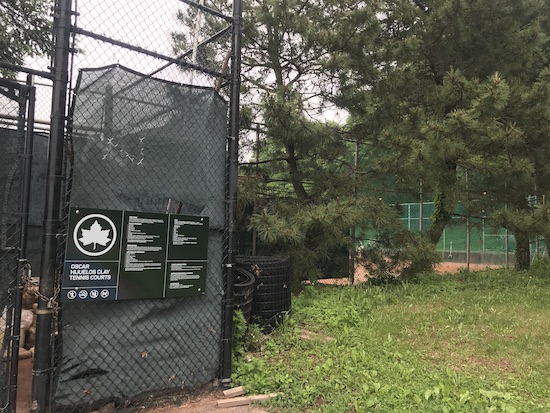




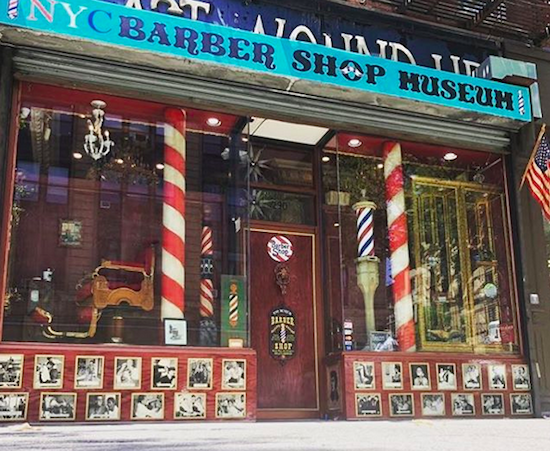
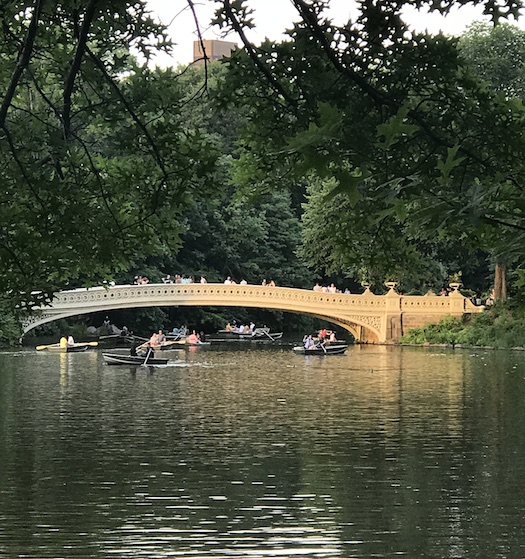
This lack of transparency by the Riverside Park Conservancy is very disturbing. I don’t play tennis but have been an RPC donor for a few years now. I’m definitely reconsidering my 2018 donation.
Per usual for-profit activities run rampant in NYC parks. People ate making a lot of money off public parkland in this town.
I have grown against the Central Park Conservancy for the same reason. These money making machines (Riverside and Central Park Conservancies) achieve nothing but collecting $$. Trying to get a Softball field in Central Park is just a difficult, as getting a tennis court in Riverside Park. The DPR (Dept of Parks & Recreation) has created more sub-agencies than it can managed. It’s a scam based on wealth and on who you know at the Conservancy, or better yet, the Parks Dept. And if you have contact in City Hall, you’re in!
I stopped by donations years ago.
Agree. Something is not right.
If I may offer an alternate viewpoint. I started playing tennis for the first time in my life – 3 years ago at RCTA. If it wasn’t for the lessons & clinics, I never would have learned to play. Because the cost to play here isn’t as extraordinary as it is in other places in the city & because I live here in the neighborhood, I’ve been lucky enough to learn how to play. So I’m just saying that there is a balance between open play and paid play (lessons, clinics) – both are valuable and both have their audiences. I don’t want to play doubles or singles. I don’t think I play well enough for either. So without the clinics, I wouldn’t be able to play. I think the article made a mistake by only talking with people who want open play. There is an entire cohort of players like me that are grateful for the lessons and clinics. Additionally, I think it’s important to point out how extraordinarily lucky we are to even have clay courts. Ours are one of the few remaining public red clay courts in the country. I am incredibly grateful for the workers & volunteers that work tirelessly so that we may all play. I’d also like people to consider that some of the profit from the lessons helps to cover the costs to keep these courts open.
Completely agree with JC here! RCTA has been an invaluable source of reasonably priced adult tennis education for me. In a beautiful setting along the Hudson River as the sun sets. I cannot afford to take lessons elsewhere.
Great points JC.
I have been playing at the red clay courts (open play, not lessons) for the past 6 years, and truly appreciate the crew (including Mark McIntyre) who maintain them, especially after rainy days.
I play June, July and August so I am not sure why the director said that. Prime time playing is 8am to 12 noo an d 6pm to 8pm.. Why not schedule kids lessons in the afternoon? Why not schedule classes/lessons in the off peak hours? Sadly this sounds like a private company making money off a public facility.
Private no pun profit partners with the City are an appalling highjacking of public assets for private benefit. As with Most so called private no pun profits that take over our parks and other public assets the ultimate goal is to hand over those spaces to for profits and cut out the taxpayers! Cut them out from use and from any control over public assets. So much for democracy.
this leads to a discussion of the central park courts where they are also using several courts for lessons at 11:00 when all the other people can’t get a court.
the other issue is the tennis building is literally falling down and because it is so dangerous it is roped off. when will the parks dept start to rebuild this monstrosity
My two children have attended the RCTA summer tennis camp. One will be attending again this summer. It is a great program. The cost is comparable to other NYC day camps. It is a relatively small program. Given my experience with RCTA, I find this article a bit sensational.
Much of the programming I see involves children, Most of the walk-on play involves adults.
Is the reporter suggesting children be shut out from playing tennis in their neighborhood park? Why not interview some of the parents and ask how the lesson fees compare to other children’s lesson around the city? (And by the way, a lot of the camp activities take place off the courts.)
Much of the adult programming is tournaments. Jeff Cohen plays in these a lot (or at least used to).
I’m thrilled with the options for classes at the 96th street courts. Since I’ve been taking classes I’ve been able to walk on to courts any time I like – typically in the evening – without issue. If they decreased the number of classes I may not be able to learn and enjoy the courts and this great sport.
The Riverside Park Conservancy has shown themselves woefully inept at fund raising. And the dreadful condition of the park is a result of the deficit. The hardscape is crumbling and all of the trees are in dire need of pruning and maintenance. Let it be hoped that new leadership–a change from a dual role– of the Conservancy will initiate needed change. I never understood why both the leadership of the Conservancy and administration of the park was vested in one individual.
You really are a grumpy old man. I am in the park almost every weekend with my children. I see people of all backgrounds enjoying themselves. Though it is far from perfect, I think that it is generally well kept and is a wonderful resource.
I used to be very proud to be an Upper West Sider. The more I read this blog (which I greatly enjoy), the more I have come to believe it is a neighborhood full of out-of-touch, neurotic whiners who are desperately seeking something new to complain about while yearning for “the good old days.” If you don’t like it, get off my lawn (which for me is the promenade in Riverside Park).
Well put. And if people don’t like the way things are, they should get out and do something about it. There are tons of volunteers who help make Riverside Park beautiful – they could always use a few more. And all of the underperforming schools that people always complain about could use more volunteers and more dollars. And all of the old stores that are closing allegedly due to high rent could use more patrons.
I’ve tried to contact the Conservancy numerous times about the large number of lights that remain on during the daytime but they don’t ever return phone calls. It’s an organization that seems to lack integrity about anything.
I don’t know specifically about Riverside’s lights but I know that Central Park’s streetlights were maintained by the Department of Transportation, not the CPC. There were a lot of lights on during the day there, too. It took many months but the DOT finally got around to repairing the string of lights.
I realize that they’re not maintained by the RPC. But as stewards for the park, they’re in the best position to find a solution to most problems. They can speak to whichever entities are responsible with a greater impact than an individual. Not returning phone calls or following up is just not acceptable.
As I recall, the central park “streetlights always on” problem was more an act of stupidity. NYPD had security cameras installed and the electricians wired them into the streetlights in many locations. This meant that the security cameras didn’t get power unless the streetlights were on.
Took a while to get that sorted out.
About administrative costs,I don’t think RCTA would be correctly categorized as a community foundation. Fora npo that operates its own programming, I’d say that 15% is a pretty good rate for admin costs. (I work in a npo fiscal department.)
Also, like JC, I enjoyed the lessons & clinics I attended at 96th St when I was younger. I really never got good enough to even play doubles but I loved being on those courts for the lessons & clinics. I recall there being only 1 official pro, who used 1 court for lessions.
Folks, I clearly understand your plight with lack of players usage. Clay public courts are unheard of in southeastern VA. Virginia Beach has several private clubs, to which I am a member of one, that have clay. But the city spends thousands upon thousands of dollars for soccer indoors, while its concrete courts are riddled with cracks, holes, faulty netting that you have to pay to use.
We went through the exact same experience at a facility in California, and the bottom line is a small vocal group with a very limited perspective will always find a media outlet that wants to make something out of nothing as that is what will gain readership and advertising. Then, the public organization and its contractor spend a lot of time and money demonstrating that they are serving the vast majority of the public and that in fact there is plenty of court time for everyone. Listen to the facts and not a few carping tongues who found a sympathetic media outlet to make a mountain out of a mole mole hill.
“will always find a media outlet that wants to make something out of nothing as that is what will gain readership and advertising… Listen to the facts and not a few carping tongues who found a sympathetic media outlet to make a mountain out of a mole mole hill.”
Your comments about the West Side Rag seem unwarranted without substantiation.
Maybe that’s how things are done in California, but we are better than that here.
As the “tennis addict” quoted in the article who (with the help of NYC Parks Advocate) obtained the RPC/NYC Parks License Agreement through a FOIA request, I just want to make it clear that a contract that is silent on something cannot be construed as allowing it. The License Agreement lists only one way for RCTA to obtain revenue (i.e. the single play tennis fee) therefore it DOES NOT ALLOW the for-pay programs that McIntyre has instituted. There is no language that says “or any other revenue producing activities that RCTA deems appropriate.” Similarly, the License Agreement is completely silent on the 119 courts, therefore giving RCTA NO AUTHORITY over those courts.
So, since NYC Parks own License Agreement doesn’t allow these profit-making activities or RCTA management of 119, the issue is why NYC Parks refuses to enforce its own contract.
Many of us believe that the “administrative fee” that McIntyre references of nearly $100,000 is his compensation. If true, that means he has created for himself an extraordinarily high salary for a seasonal job that he began as an unpaid volunteer. If true, he’s making more than teachers, social workers, 1st responders, etc. which is, of course, outrageous.
If true, it is a corruption that must be stopped by NYC Parks, not encouraged and expanded. An individual should not be permitted to enrich himself by exploiting a public facility. If McIntyre wants to dispute this salary claim, let him or RCTA disclose his salary history. I don’t blame McIntyre for getting away with all he can. I blame Mitchell Silver as Commissioner of the Parks for allowing it and, ultimately, it is Mayor DiBlasio who must be held accountable.
The RCTA has a 15 person Board of Directors with each member serving a 3 year term. Unlike many other boards, this board has a very high turnover, involving many community members over the years (i.e. not a select group of insiders).
As a former board member, I know first hand that staff salaries (and programming) are approved by the board, which represents the community.
Jeff, what I find odd here (and perhaps hypocritical) is that you have participated in this supposed ‘unauthorized’ program revenue by playing in many, many RCTA tournaments. Are you opposed to revenue-generating programing in general, or just the programming that doesn’t increase your personal playing time?
Shame on the West Side Rag for not telling the full story and allowing one disgruntled player to cast doubt on one of the West Side’s best facilities, user groups, and its staff.
(And just a note to the reporter: if your story is trying to claim that programming is limiting walk-on play, it might be best to show a photo of programming (when there are typically 6 or more players on a single court). The photo of empty 119 St. tennis courts makes a very good case that the facility could use more programming, and better use.)
I use the courts about once a week weather permitting, have no connection to the lessons/parks dept etc and after using the courts for a few years decided to join the rcta because I see the good they do. My take: I generally think the reporting in west side rag is solid, but in this case I feel the article does a disservice to this community resource and those who use it by taking one man’s assertion and trying to build an article around it. Alex Israel could not find ANY players at the courts who had anything nice to say about the lessons? Did the reporter bother going to the courts? I can tell you the group lessons fill very quickly because they are very reasonably priced compared to most other places (so = A PLUS for the community). Did the reporter bother comparing the price of a lesson at Central Park vs at Riverside Park (google and the answer, no surprise, is that it is significantly less.) Also NOT mentioned in the article: much of the equipment at the courts — ie netting, sweeping brushes etc is paid for through donation and membership RCTA money and not by the city.
I would not be surprised if the people complaining don’t contribute anything toward upkeep of the courts which by the way, a large team of VOLUNTEERS helps run smoothly.
Re the resurfacing timing — no mention of the unusual weather we have had this year and its impact on the ability to resurface the courts.
When I use the courts, the first couple are often used for group/kids/private lessons and the rest of the courts are for whoever signs–first come first served. I’ve been there at 4pm during the week and had no wait for a court; 5pm for a one hour wait. Those wait times are not unusual for public courts. West Side Rag please keep up the generally solid reporting and don’t let one person use you as a tool to get what he wants.
Great job, RCTA…BEAUTIFUL COURTS, wonderful volunteer efforts. I walk by the courts frequently, and there are almost always several empty courts. Classes and clinics help grow the sport of tennis, and support the maintenance of CLAY courts. (To be efficient, the city would bring in asphalt…and what about the lovely, volunteer created gardens?) This is New York…it costs money to improve our parks and the recreational facilities in them. If it weren’t for Riverside Park Conservancy and RCTA, our park would be in far worse shape. Go read RPC’s 990…all nonprofits file them with the IRS..no one is getting rich here, but our parks are richer.for their steadfast efforts. Again, thanks RCTA for all you do for the community of tennis players in NYC.
VERY BIASED REPORTING AND A DISSERVICE TO THE KIDS. The article is painting an ugly picture of a community that has provided an outlet for kids to be children. RCTA provides summer programs at reasonable costs. It’s a far better cry than having obese kids playing video games indoors. The social anxiety for multi-player team sports is minimized in tennis.
Occasionally, I frown upon affluent families having nannies gossiping while the kids are on the courts. But that’s what the typical household living in the UpperWestSide. Let’s step back and see the bigger picture. RCTA is building many generations of tennis players by starting them young. WITHOUT RCTA, I WOULD BE AN OBESE ADULT. Sure, I’ve been turned away because the courts were booked for hours… but I don’t complain because I waited for the next available and have made wonderful friends throughout the years.
The glass is always half full.